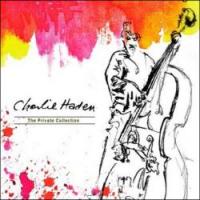Charlie Haden Birthday Party Gig Open to All!
From the NAIM archives comes this triple LP/double CD set, originally issued as two, long out of print, individual CDs, featuring Charlie Haden’s Quartet West, featuring Saxophonist Ernie Watts, pianist Alan Broadbent and the late, great drummer Billy Higgins on one session and the great, not late Paul Motian on the other.
CD one (LP sides 1,2 and most of 3) was recorded August 6th 1987 at “At My Place,” a small Santa Monica, California nightclub with family and friends during a celebration of Haden’s 50th birthday (making Haden just about 73 as this is written), while the second is from an April, 1988 concert recorded at St. Louis Missouri’s Webster University (Haden is a Missouri native).
On the first set, the quartet takes liberties with Pat Metheny’s bucolic “Hermitage,” from 1979’s solo guitar album New Chautauqua (ECM -1-1131 LP), produces a spine tingling romp through Charlie Parker’s jumpy “Passport,” a lyrical edition of Miles’ “Nardis” and a suitably blue take on Tony Scott’s oft-covered “Misery,” with Mr. Watts getting positively weepy. There are two very different versions of Metheny’s “Farmer’s Trust,” one from each set, with a rapid fire take on the first, and a more cerebral one on the second.
Disc two (LP sides 4,5 and 6) produces many nice moments, including the tuneful Haden original “Bay City,” with the stand out being a mesmerizing, serpentine version of Ornette Coleman’s “Lonely Woman” that unwinds, almost violently over the course of its 22 minutes.
The two mic analog recording by engineer Ken Christianson is spacious, unprocessed, tonally honest and everything you might expect from an audiophile production, though with music that’s far better than many of them.
I was reading an online blog about vinyl and while most respondents have come to realize that for whatever reasons, vinyl sounds better (it was hard to find anyone who thought that a decade ago), there’s no point in buying a record sourced from “digital.”
Of course I take issue with that based both conceptually and on experience. For instance, which do you think might sound better: a record sourced from a 96K/24 bit file? Or the CD “dumbed down” to 44.1K/16 bit? It’s no contest if you’ve ever compared, say, Bruce Springsteen’s Live in New York (Columbia C385490) on triple LP sourced from an 88.2K/24 bit digital file and the CD. The record creams the CD.
But what about a record sourced from a 44.1K/16 bit file? Why bother with it when the CD’s resolution is identical? Well, who’s got better D/A converters? The mastering engineer? Or you? Chances are the mastering engineer’s gear will be better. In any case, for whatever reasons, even LPs cut from “red book” CD sources sound more pleasing.
“Euphonic colorations?” Who cares? All I know is, when I compare these the 3 LP set of this NAIM produced Haden set to the double CD edition, the record sounds like you’re “there” and the CD doesn’t, particularly when you compare the cymbals. I sat in the third row just last night at a fabulous Charles Lloyd concert and I paid particular attention to the cymbals (not at the expense of the music, believe me!). Sorry, but CD still just doesn’t get it right. The LPs, for whatever reasons do!
I guess you could say digital’s come a long way since the LP was mastered from a digital copy of the original analog tapes recorded in 1987 and 1988 and nothing in the vinyl presentation sounded “digital” in the ways most of us connect to the word. But without hearing an LP sourced directly from the analog masters, it’s difficult to say just how much, if anything was lost in the digital transfer. Why Steve Rooke couldn’t cut using the original analog tapes I don’t know, but what counts is the final result and the triple LP set, beautifully packaged, is a treasure worth having, musically and sonically.
- Log in or register to post comments


